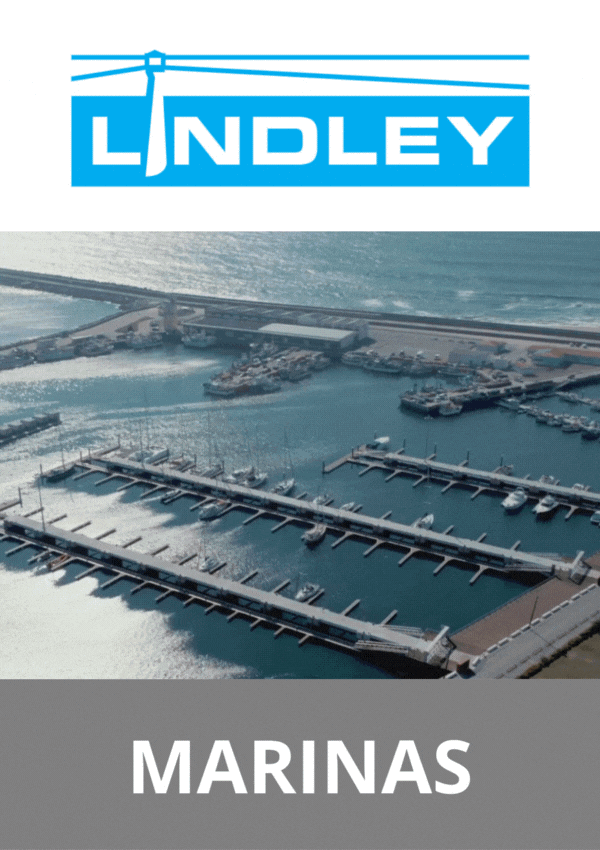Building a future for UK drystack
Drystack is increasingly offering UK motorboaters a convenient and secure alternative for boat storage. Various operators across the UK are expanding their drystack provision and optimising customer services for an exciting and growing market. Marina World checked in with Bembridge Yacht Storage and multi-marina operators Yacht Havens, MDL Marinas and Premier Marinas for the current management overview. Mel Symes reports
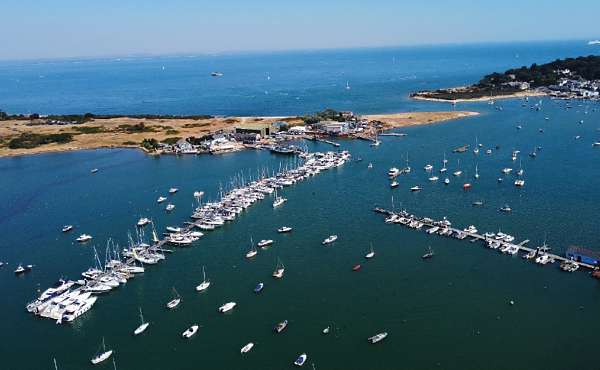
Bembridge Boat Storage, the only drystack on the Isle of Wight, is increasingly popular with boaters. The harbour owners are awaiting planning approval to extend the drystack facility.
Another consideration is that boats are getting bigger overall, wider and with more draught, creating additional demands on marina space. Drystack, however, needs to fit certain parameters – it’s not the best fit for every type of marina, location or aesthetic. Whilst it can increase the storage capacity of a marina if the footprint is limited, it also needs to be fully supported from a customer and technical perspective.
Yacht Havens has one of the UK’s first drystacks at Yacht Haven Quay in Plymouth, and another popular facility in Haven Quay, Lymington, which benefits from the services offered by the adjacent marina and boatyard. With 200 spaces in each location the company finds that a sunny afternoon can generate up to 40-50 launches, attracting some 200 people to a single site. Group marketing manager, Jonathan Cook, shared his thoughts: “What’s really interesting about drystack is the dynamic with the customer. Lifting and launching can generate far more interaction with a boater than a wet berth where the boater is more autonomous, and we might only meet them on the pontoon. This opportunity for engagement implies that boatyard operatives need a specific skill set including the capacity to build rapport with customers and enhance relationships. They need to be able to recommend cruising destinations and ensure that the boater feels part of the community and that their boating experience is positive and memorable.
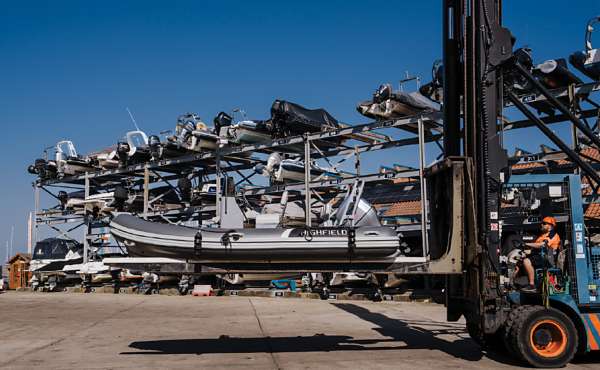
MDL Marinas’ Hamble Point Marina is a 230-berth marina offering easy access to the famous waters of the Solent. Its associated drystack system has storage for 137 boats.
At this end of the market, owners are less invested in their vessel and so their level of commitment might not be comparable to a larger sailing boat. Drystack invariably involves smaller vessels - it’s up to us to make sure that customers continue to perceive value in their boats.”
Harbour owners, Malcolm and Fiona Thorpe, own Bembridge Harbour, which hosts Bembridge Boat Storage, the Isle of Wight’s only drystack storage: a 20,000m² (215,300ft²) waterfront shed and site converted from a previous hovercraft manufacturing facility.
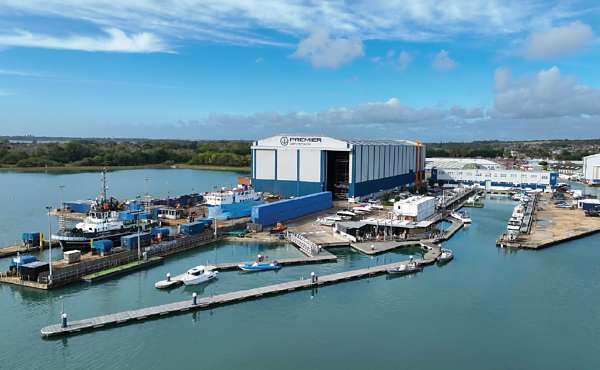
Trafalgar Wharf, a Premier Marinas facility.
MDL’s first facility in Cobbs Quay dates from 2000. The company now offers a total of 547 drystack spaces across its portfolio of marinas for vessels up to 13m (43ft). MDL Marinas sales and marketing director, Tim Mayer, described some of the efficiencies for drystack customers: “A drystack boater will appreciate reduced maintenance bills and less wear and tear on their vessel. Dry storage eliminates the need for antifouling which provides an environmental bonus. Less growth on the hull also equates to less drag, so better fuel economy.
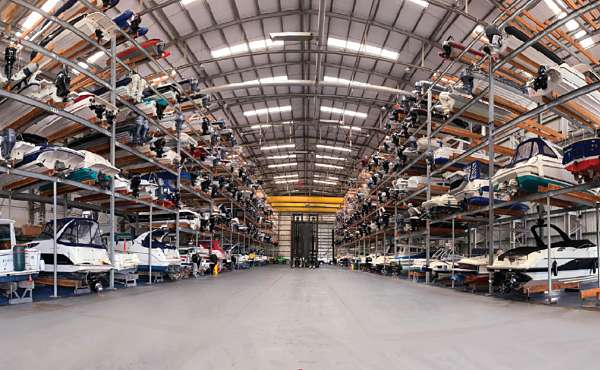
Trafalgar Wharf, a Premier Marinas facility, is the largest indoor drystack in Europe, racking over 300 motorboats and RIBs of 4-13m (13-43ft). The facility is in the heart of Portsmouth Harbour on the south coast of England.
With marketing data dating back five decades, MDL Marinas benefits from sophisticated predictive analytics for customer retention, working hard to deliver value to boaters and make sure that they feel included within the boating culture. With high capacity, MDL is able to assert that its occupancy rates outperform industry averages.
Mayer describes an interesting market outlook: “We’ve observed that smaller powerboat ownership, including drystack storage, attracts a broader age demographic compared to wet berths. While the 65+ and 55-64 age groups dominate larger vessel ownership, we’re seeing younger owners (under 54) gravitating toward vessels under 7m [23ft]. The market experienced growth from 2020 to 2022, followed by a brief decline, but is now showing steady recovery as customers recognise the value proposition of drystacking.”

Drystack boat storage is available at Premier Marinas’ Swanwick Marina on the River Hamble for motorboats and RIBs up to 11m (36ft) in length.
“Indoor storage contributes to preservation of the boat as an asset, protecting it from damaging UV radiation in the summer and harsh conditions in winter. Enjoying access to the same services and benefits as our wet-berth customers, the boater can have their boat launched within the hour using our app, offering the means to make last minute decisions. They also have unlimited launches within their contract maximising the opportunity to spend time on the water and providing flexibility if plans need to be changed. Simply put, we’re offering on-demand boating.”
Environmental considerations are also improving. Premier’s Noss on Dart Marina has a closed circuit washdown facility allowing for water to be recycled, and yard machinery in each of Premier’s marinas runs on HVO. Extensive solar power contributes to their net zero target.
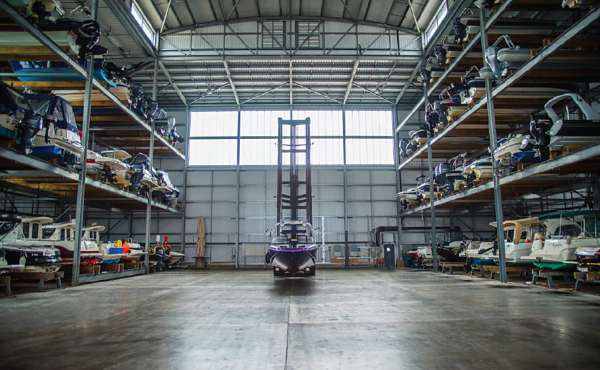
Yacht Haven Quay Plymouth was one of the first drystacks in the UK and racks around 200 vessels.
Whether drystack corresponds to the more affordable end of the market is much debated. At first look this should be the case, but managing a drystack tends to be staff and machinery intensive with a high cost of purchasing and operating industrial lifting equipment. A large tidal coefficient makes further demands on infrastructure, where launching into sea water also implies potential saltwater corrosion, requiring a frequent, proactive and specialised maintenance regime. Constant use also increases wear and tear meaning that some companies feel obliged to double up on machinery to avoid downtime for failures and maintenance.”
Malcom Thorpe adds some key insights: “Lessons we’ve learned along the way is that there is never enough car parking should all our customers want their boats launched on the same day - as a result, we now make use of one of our marina car parks and ferry the owners to our drystack operation. Equally, getting the business going was pretty demanding, between obtaining planning permission, offering a new seven-day service and promoting drystack to a customer base that wasn’t familiar with the concept.”
Collectively, drystack operators recognise a need to continue to raise awareness amongst boaters about the benefits of this style of boat ownership, and reach out to brokers, insurance agents and the wider boating community to make sure that people understand the advantages. Welcoming drystack customers into boating culture is paramount, and many have attractive F&B facilities nearby where people can gather and watch boats being launched.
The vote is in however: for smaller motorboats and RIBs, drystack is the future!

